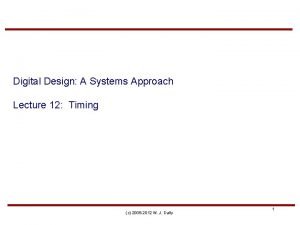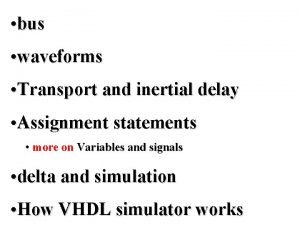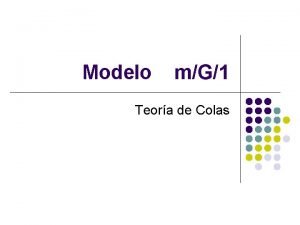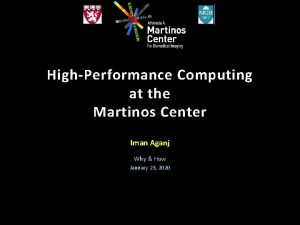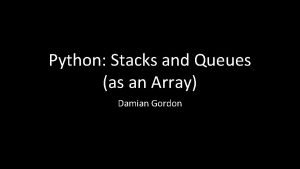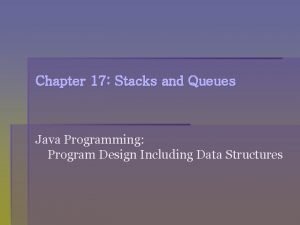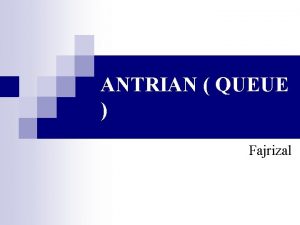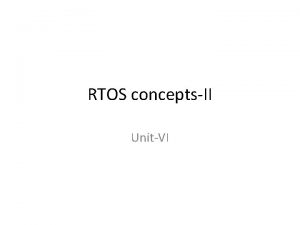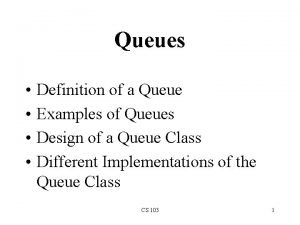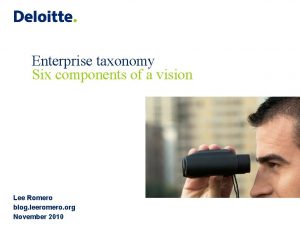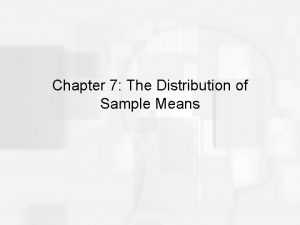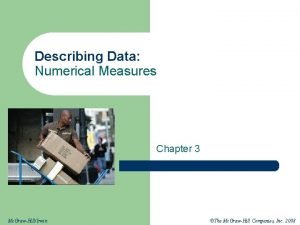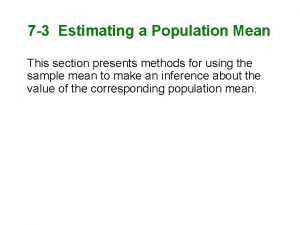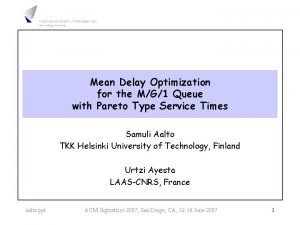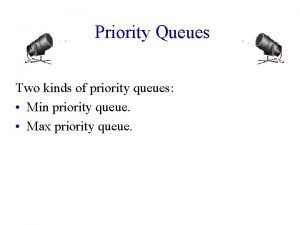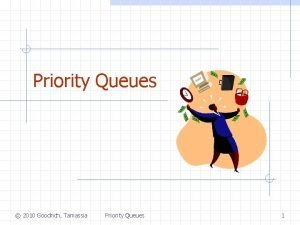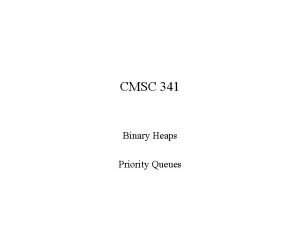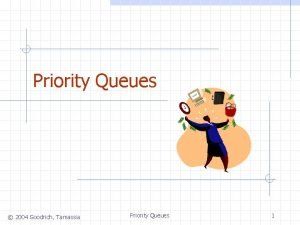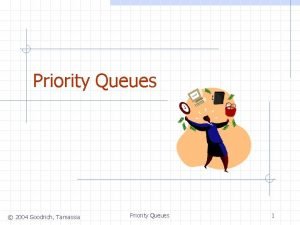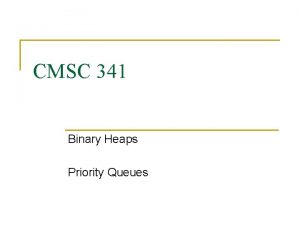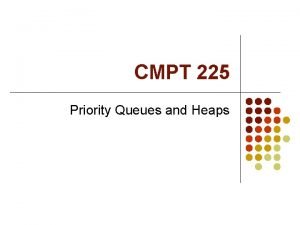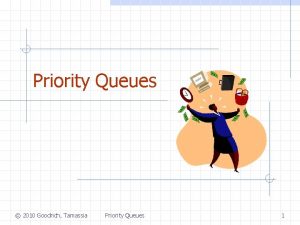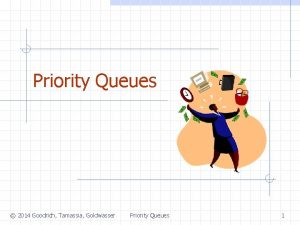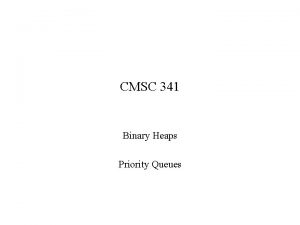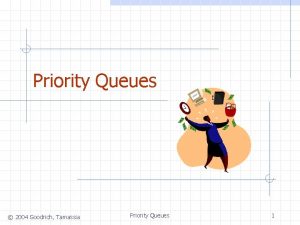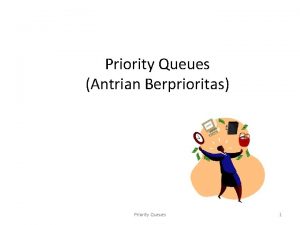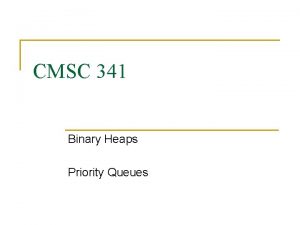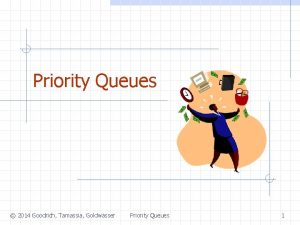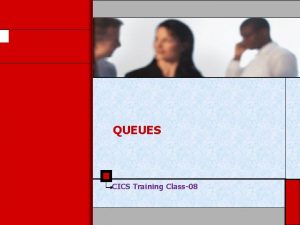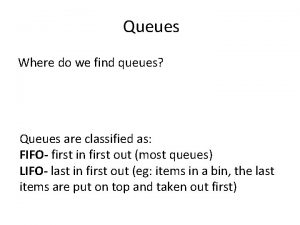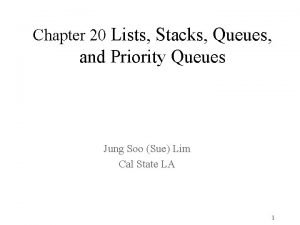Mean Delay in MG1 Queues with HeadofLine Priority























- Slides: 23

Mean Delay in M/G/1 Queues with Head-of-Line Priority Service and Embedded Markov Chains Wade Trappe

Lecture Overview l Priority Service – – – l Setup Mean Waiting Time for Type-1 Mean Waiting Time for Type-2 Generalization Summary Embedded Markov Chain Technique – Nk inside of N(t) – The queue distribution for M/G/1 u The PGF approach – Example: M/H 2/1 Queue – Homework: Alternate Pollaczek-Khinchine Derivation

M/G/1 Priority Services: Setup l Consider a queue that handles K priority classes of customers – Type-k customers arrive as a Poisson Process with rate l l and service times Customers are separated as they arrive and assigned to different “prio Each time the server is free: – Selects the next customer from highest priority, non-empty queue – This is the “head of line” service – We also assume that customers are not pre-empted! l Server Utilization for type-k customers is l Stability requirement:

Priority Services: Explanation 1 Queue-1 1 2 Server 2 Queue-2 Blue Type-1 Packets always have priority, but cannot preempt Type-2 packets

Priority Services: Mean Waiting Times l Our first goal will be to calculate the mean waiting time for Type-1 c l Assume a type-1 customer arrives and finds Nq 1(t)=k 1 type-1 already l Assume we use FCFS within each class l W 1 consists of: – Residual time R of customer in server – k 1 service times of type-1 in queue l Thus: l We get the mean waiting time for type-1 as

Priority Services: Mean Waiting Times, pg 2 l Now, let us look at a type-2 customer. When he arrives he may find – Nq 1(t)=k 1 type-1 already in the queue-1 – Nq 2(t)=k 2 type-2 already in the queue-2 Thus, W 2 is the sum of: – Residual service time R – k 1 service times for type-1 customers – k 2 service times for type-2 customers – AND service times of any new type-1 customers!!! l We get the mean waiting time for type-2 as l

Priority Services: Mean Waiting Times, pg 3 l Here, M 1 is the number of customers of type-1 that arrive during type l By Little’s Theorem applied to the queues: l The mean number of type-1 arrivals during l Substitute to get seconds is

Priority Services: Mean Waiting Times, pg 4 l Solve for : l Generalizing gives l Now, we’re left with finding E[R]!

Priority Services: Mean Waiting Times, pg 5 l When a customer arrives, the one being serviced can be of any type! l We will use the same formulation as where is the aggregate Poisson Process rate. l To get E[X 2] we use the fact that the fraction of type-k customers is l Thus, we get

Priority Services: Mean Delay l Now, calculating the mean delay for a type-k customer is easy! l From this, observe: – Class-k customers are affected by the behavior of lower priority c

Embedded Markov Chain Methods for M/G/1

The Embedded Markov Chain l l Let Nk be the number of customers found in the system just after the service completion of the k-th customer Let Ak be the number of customers who arrive while the k-th customer is served l The Ak are i. i. d. l Under FCFS: Ak is independent of N 1, N 2, …, Nk-1 l Nk is not independent of Ak Nk-2 Nk Nk-1 N(t) Time Ck-2 Xk-1 Ck-1 Xk Ck Service Ck-1 Ck Queue Ck-1 Ck Ak-1=1 Ck+1 Ak=3

Embedded Markov Chain, pg 2 l We may find the following recursion: l Where did first line come from? – If l , then k-th customer finds the system empty, and on departure he The second line: – The queue left by the k-th customer consists of the previous queue decreased b l Let U(x)=1 for x>0 and U(x)=0 for x<=0 l Then we get

Embedded Markov Chain, pg 3 l From we can see that Nk is a Markov Chain since Nk depends on the past only l Nk is called the embedded Markov Chain l (Homework): The distribution for N(t) and Nk are the same: – Step 1: Show, in M/G/1, distributions found by arriving customer – Step 2: Show, in M/G/1, the distribution of customers found by ar l We will analyze Nk instead of N(t)

M/G/1 Queue Distribution l To find the queue distribution, we use the probability generating func l The PGF of the distribution {pn} is l Substitute l Thus and use independence to get

M/G/1 Queue Distribution, pg. 2 l If the service time of customer k is t, then Ak has a Poisson distributi l Now multiply by the f. X(t), the pdf of the service time Xk, This gives t l Integrate out X to obtain the unconditional pdf of Ak l What does this remind you of? l Answer: Laplace Transforms!!!

M/G/1 Queue Distribution, pg. 3 l The Probability Generating Function of Ak is given by Laplace Transform of f. X(t) l Substitute into earlier result to get:

M/G/1 Queue Distribution, pg. 4 l We need to now find p 0! l To do this, look at limit as z goes to 1, and apply L’Hopital… l First, go back to l Observe that P(z=1)=1, Ak(z=1)=1 l Thus l We used: Show This!

M/G/1 Queue Distribution, pg. 5 l Thus, l This is exactly what we got for M/M/1 Queues!!! l Substitute into earlier result to get: l What do we do with this? Use it to find the probability distribution pn l How? Equate terms… Best to see an example

M/H 2/1 Queue l Consider the case where FX(t), the cdf, is a two-term hyper-exponent l Where do hyper-exponentials come from? – In practice, from situations where service times can be represented as a mixture – That is, suppose there are k types of customers, each occuring with a probabilit – Customer of type I has a service time exponentially distributed with mean 1/mi l Then the density is

M/H 2/1 Queue, pg. 2 l Back to our 2 -phase hyper-exponential problem… l The mean service time is given by l The Laplace Transform of f. X(t) is: l We thus get:

M/H 2/1 Queue, pg. 3 l The PGF of {pn} is l The probability distribution is obtained through partial-fraction expa l To do this, we must find the roots of the denominator… call these z 1 l Then P(z) has the form: = Total Traffic Intensity

M/H 2/1 Queue, pg. 4 l Solving for C 1 and C 2 involves setting z=0 and z=1 to get l Finally, upon substitution, we get:
 Adaptable priority queue
Adaptable priority queue Applications of priority queues
Applications of priority queues Queue quiz
Queue quiz Timer symbol in plc
Timer symbol in plc Propagation delay and contamination delay
Propagation delay and contamination delay Assignment statement
Assignment statement Modelo m/g/1
Modelo m/g/1 Priority mail vs priority mail express
Priority mail vs priority mail express Burman's priority list gives priority to
Burman's priority list gives priority to Java stack exercises
Java stack exercises Martinos email
Martinos email Empty python
Empty python Ipcs unix
Ipcs unix Java stacks and queues
Java stacks and queues Java stacks and queues
Java stacks and queues Types of queue in data structure
Types of queue in data structure Pipes in rtos
Pipes in rtos Representation of queues
Representation of queues Enqueue and dequeue meaning
Enqueue and dequeue meaning Steps to find the mean absolute deviation
Steps to find the mean absolute deviation What does mean mean
What does mean mean If σm = 4 and n = 36, then σ =:
If σm = 4 and n = 36, then σ =: Mean deviation from mean
Mean deviation from mean How to calculate point estimate
How to calculate point estimate




